Do you have a question about the Kenwood KRF-V8010D and is the answer not in the manual?
Voltage compatibility and mains plug information.
Instructions for unpacking and damage inspection.
Lists all accessories provided with the receiver.
Critical warnings to prevent fire and electric shock.
How to clean the unit's exterior safely.
Explains the manual's structure and how to navigate it.
Highlights key functionalities like Dolby Digital and remote control.
Details the display, buttons, and indicators on the front panel.
Explains the purpose of the standby indicator.
Details the functions of various remote control keys.
Guides on connecting audio sources like CD players and cassette decks.
Troubleshooting steps for microcomputer issues.
Advice on ventilation and space requirements for the unit.
Instructions for connecting video sources like DVD players and VCRs.
Explains how to connect digital audio sources like Dolby Digital and PCM.
How to select input modes (Auto, Manual, Analog, DVD 6ch) for digital/analog sources.
Specific settings for DVD players with 6-channel output.
Diagram and instructions for connecting DVD 6-channel sources.
Guides for connecting AM loop and FM antennas.
How to connect system control cords for convenient operation.
Details on remote control and automatic operation via system control.
Instructions for changing system control modes.
How to register setup codes for remote control of other components.
Guides for connecting front, center, and surround speakers.
Lists speaker impedance requirements for different speaker types.
Explains how to use preout jacks for external amplifiers.
Recommended placement for front, center, surround, and subwoofer speakers.
Instructions for loading batteries and basic remote control operation.
Step-by-step guide to configuring speaker settings for optimal surround sound.
Preparatory steps before starting playback.
How to power on the receiver and related components.
How to select the correct input for TAPE/MD decks.
How to choose between speaker systems A, B, or both.
How to set input modes for VIDEO2/VIDEO3 jacks.
How to select and listen to various audio sources.
How to adjust tone controls (Bass, Treble) and bass boost.
How to mute and unmute the speaker output.
How to bypass audio processing for direct signal path.
How to connect and use headphones.
Steps for recording audio from various sources to tape.
Instructions for copying tapes between decks.
How to use the monitor function with external components.
Steps for recording video sources to a video deck.
How to tune to standard AM/FM radio stations.
Explains RDS features like PTY, EON, PS display, and Auto Memory.
How to cycle through display modes (PS, RT, Frequency).
Automatic storage of up to 30 RDS radio stations.
How to manually store AM and FM stations into presets.
How to tune to stored radio stations using numeric keys.
How to sequentially access preset stations.
Search for radio stations based on program genre.
Setting up EON for traffic/news announcements.
Explains the TP indicator for traffic information.
How to turn off EON reservation.
How to set a specific volume level for information broadcasts.
How to disable the TI volume setting.
Explanation of the Dolby Pro Logic surround sound mode.
Overview of different surround sound modes.
Details on the Dolby Digital (AC-3) surround sound format.
Explanation of the Dolby 3 Stereo mode for systems without surround speakers.
How to enjoy surround sound from DVD 6-channel sources.
How to play content in various surround modes.
Steps for enjoying surround sound from DVD 6-channel sources.
Describes useful functions like Midnight mode and display dimmer.
How to adjust sound settings like Bass, Treble, and subwoofer volume.
Compresses dynamic range for night listening.
How to adjust the subwoofer volume using the remote.
How to change the brightness of the receiver's display.
Procedure to reset the microcomputer to its factory state.
Troubleshooting symptoms and remedies for amplifier issues.
Troubleshooting symptoms and remedies for tuner issues.
Technical specifications for the audio output and input sections.
Technical specifications for video inputs and outputs.
Technical specifications for the FM tuner.
Technical specifications for the AM tuner.
General specifications like power consumption and dimensions.
Information on which settings are lost when power is disconnected.
Australian specific specifications for audio output and input.
Australian specific specifications for video inputs and outputs.
Australian specific specifications for the FM tuner.
Australian specific specifications for the AM tuner.
Australian specific general specifications like power consumption.
Voltage compatibility and mains plug information.
Instructions for unpacking and damage inspection.
Lists all accessories provided with the receiver.
Critical warnings to prevent fire and electric shock.
How to clean the unit's exterior safely.
Explains the manual's structure and how to navigate it.
Highlights key functionalities like Dolby Digital and remote control.
Details the display, buttons, and indicators on the front panel.
Explains the purpose of the standby indicator.
Details the functions of various remote control keys.
Guides on connecting audio sources like CD players and cassette decks.
Troubleshooting steps for microcomputer issues.
Advice on ventilation and space requirements for the unit.
Instructions for connecting video sources like DVD players and VCRs.
Explains how to connect digital audio sources like Dolby Digital and PCM.
How to select input modes (Auto, Manual, Analog, DVD 6ch) for digital/analog sources.
Specific settings for DVD players with 6-channel output.
Diagram and instructions for connecting DVD 6-channel sources.
Guides for connecting AM loop and FM antennas.
How to connect system control cords for convenient operation.
Details on remote control and automatic operation via system control.
Instructions for changing system control modes.
How to register setup codes for remote control of other components.
Guides for connecting front, center, and surround speakers.
Lists speaker impedance requirements for different speaker types.
Explains how to use preout jacks for external amplifiers.
Recommended placement for front, center, surround, and subwoofer speakers.
Instructions for loading batteries and basic remote control operation.
Step-by-step guide to configuring speaker settings for optimal surround sound.
Preparatory steps before starting playback.
How to power on the receiver and related components.
How to select the correct input for TAPE/MD decks.
How to choose between speaker systems A, B, or both.
How to set input modes for VIDEO2/VIDEO3 jacks.
How to select and listen to various audio sources.
How to adjust tone controls (Bass, Treble) and bass boost.
How to mute and unmute the speaker output.
How to bypass audio processing for direct signal path.
How to connect and use headphones.
Steps for recording audio from various sources to tape.
Instructions for copying tapes between decks.
How to use the monitor function with external components.
Steps for recording video sources to a video deck.
How to tune to standard AM/FM radio stations.
Explains RDS features like PTY, EON, PS display, and Auto Memory.
How to cycle through display modes (PS, RT, Frequency).
Automatic storage of up to 30 RDS radio stations.
How to manually store AM and FM stations into presets.
How to tune to stored radio stations using numeric keys.
How to sequentially access preset stations.
Search for radio stations based on program genre.
Setting up EON for traffic/news announcements.
Explains the TP indicator for traffic information.
How to turn off EON reservation.
How to set a specific volume level for information broadcasts.
How to disable the TI volume setting.
Explanation of the Dolby Pro Logic surround sound mode.
Overview of different surround sound modes.
Details on the Dolby Digital (AC-3) surround sound format.
Explanation of the Dolby 3 Stereo mode for systems without surround speakers.
How to enjoy surround sound from DVD 6-channel sources.
How to play content in various surround modes.
Steps for enjoying surround sound from DVD 6-channel sources.
Describes useful functions like Midnight mode and display dimmer.
How to adjust sound settings like Bass, Treble, and subwoofer volume.
Compresses dynamic range for night listening.
How to adjust the subwoofer volume using the remote.
How to change the brightness of the receiver's display.
Procedure to reset the microcomputer to its factory state.
Troubleshooting symptoms and remedies for amplifier issues.
Troubleshooting symptoms and remedies for tuner issues.
Technical specifications for the audio output and input sections.
Technical specifications for video inputs and outputs.
Technical specifications for the FM tuner.
Technical specifications for the AM tuner.
General specifications like power consumption and dimensions.
Information on which settings are lost when power is disconnected.
Australian specific specifications for audio output and input.
Australian specific specifications for video inputs and outputs.
Australian specific specifications for the FM tuner.
Australian specific specifications for the AM tuner.
Australian specific general specifications like power consumption.
| Number of Channels | 5 |
|---|---|
| Tuning range | FM: 87.5 - 108 MHz, AM: 530 - 1710 kHz |
| Frequency Response | 10Hz-100kHz |
| Input Sensitivity | 200mV (line), 2.5mV (MM phono) |
| Speaker load impedance | 8 ohms |
| Digital inputs | coaxial, optical |
| Video Connections | composite, S-Video |
| Dimensions | 440 x 143 x 403mm |
| Weight | 11.5 kg |
| Power Output | 100 W per channel (8 ohms) |
| Total Harmonic Distortion (THD) | 0.08% (20Hz-20kHz, 8 ohms) |

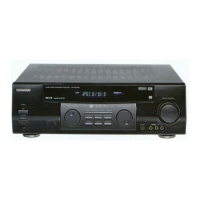
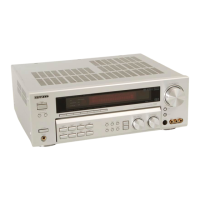
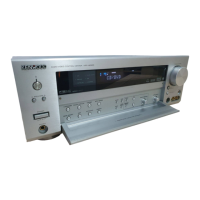


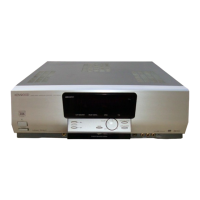
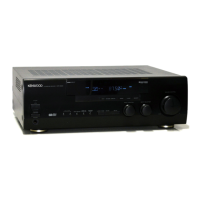
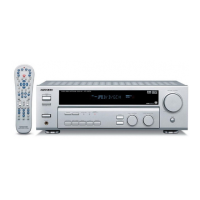

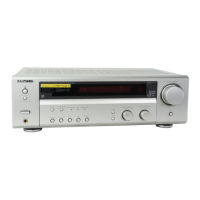

